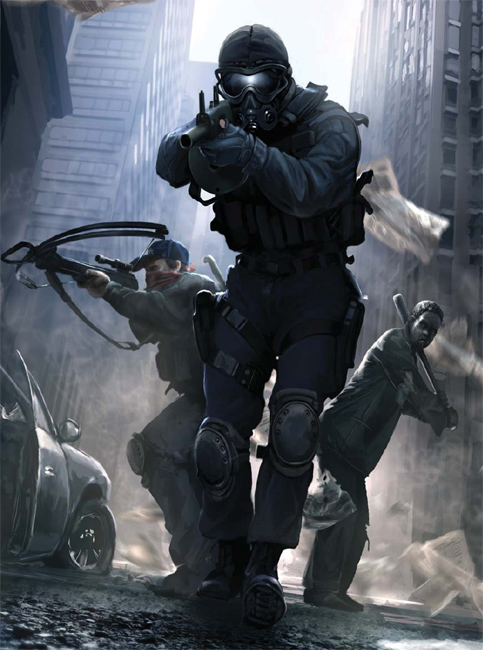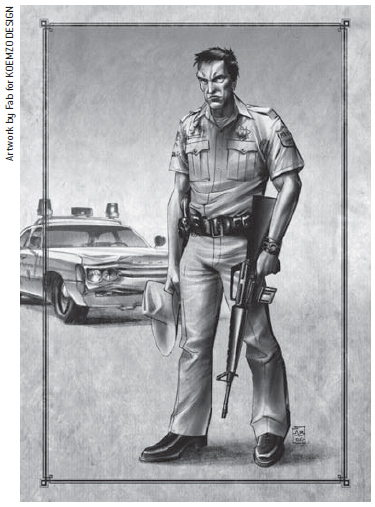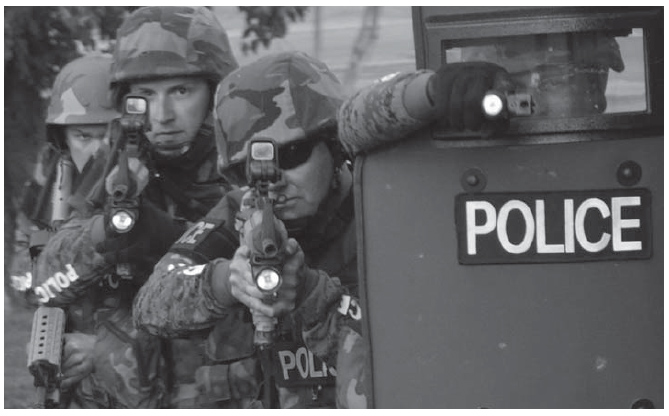Zombies (11 page)

Founded in the early years of the twenty-first century, the Zombie Dueling Association is an underground gladiatorial society which pits captured zombies against hired gladiators. Outlawed in every civilized country, the society holds secret events all over the world, including a yearly championship on a large ship in international waters. Zombies are supplied by several less-than-reputable mercenary organizations, while most of the gladiators come from the same place. However, occasionally gladiators are hired from professional sports, with former American Football players being in high demand. To become a member of the ZDA requires deep pockets, friends in the right places, and a complete lack of compunction. The ZDA is organized into a number of different clubs, each of which supply their own gladiators and zombies. It is estimated that there are over 300 members worldwide.

In 2009, the United States experienced its largest and most public viral zombie outbreak in downtown Los Angeles. Over a period of four days, members of the US Army's 34th Regiment barricaded eighteen city blocks and launched a series of reconnaissance and rescue missions into the infected area. Dubbed the “LA Bust-out” by the media, the mission proved a huge success and for the first time brought the US Army's specialist zombie hunters into the public eye.
The story of professional government zombie-hunting teams begins during the American Civil War. As mentioned previously, this war included a huge rise in necromantic activity. Realizing that the Union faced a threat perhaps even greater than the Confederacy, Abraham Lincoln asked the head of his bodyguard, Allan Pinkerton, to establish a new bureau to combat the problem. Pinkerton in turn gave the task to two of his most trusted men, Agents Rufus Thurston and Roland Briscoe. These two men established “Bureau 9,” a hand-picked team of agents who traveled the country undercover, eliminating necromantic threats. The men usually worked in pairs. One agent served mainly as the investigator, identifying and studying potential threats. The second man carried the gun.

After the war, President Andrew Johnson decided the bureau should continue its work. Records from this time are still classified and will probably remain so indefinitely. Still, it is well known that Bureau agents continued their work outside of the United States, traveling all through North, South, and Central America, and played a major part in the US interventions in Haiti. During World War II, the agents participated in many activities of the Shadow Theater. Today, Bureau 9 continues its work as a joint project of the FBI and CIA. Their main targets remain necromancers and bokors, but their activities also cover other zombie threats. Unlike the old days, however, when a serious threat arises they turn over operations to the military.
While the zombie problem remained mostly necromantic in nature, governments deemed it best to have small organizations such as Bureau 9 deal with the threat and only call out the military in extreme circumstances. But with the rise of atomic zombies after World War II, a new solution became necessary. No longer could zombie situations be resolved with one well-placed bullet. Only boots on the ground could lay down enough firepower to stop a full outbreak.
The Vatican City was the first country to officially establish anti-zombie forces in 1955, and many countries still send observers to see these specialist members of the Swiss Guard in action. However, these teams have limited reach and are only rarely deployed. The real advent of the military zombie hunters came in 1963 with the NATO “Containment Ordinance.” This small reorganization of military forces established specialist “Containment Teams” that could deploy quickly to suppress any zombie outbreak. These teams were multinational forces, with members drawn from all NATO countries. Containment team members received special training in combating zombies (all varieties) and specialist gear (see next chapter). While NATO still maintains a number of containment teams that can be deployed by helicopter or airlift, almost all of the member nations have now established similar organizations within their own militaries.
In the United States, the “Nightmen” of the 34th Specialist Regiment are based at Fort Bragg. The regiment boasts nearly 1,500 troops, including specialist support staff, and a dedicated flight of Black Hawk helicopters. The United Kingdom recruits most of its zombie hunters from the ranks of the Royal Marine Commandos, placing them in a unit known as Division 77, “The Dirge.”

Some smaller countries employ special anti-zombie police units.
With the vast increase in the zombie threat over the past two decades, a number of private military companies have seen an opening in the market. Call them “private zombie contractors” or “undead disposal specialists,” they are essentially mercenaries who specialize in fighting zombies. Like standard mercenaries, the different groups vary greatly in both ability and reliability. Some of these so-called organizations are little more than “wannabe” zombie hunters with a couple of hunting rifles and an armored pickup truck. Others are multinational corporations who employ numerous former containment team soldiers and supply them with the latest military hardware. Since most First World nations support their own containment teams, mercenaries are most active in less-developed countries, with South America, Africa, and parts of Asia being their main stomping grounds.
To date the most successful and widely recognized of these organizations is
Command: The Blue Marble
(C:TBM). Originally established in South Africa in 1997, the group now supports bases in 19 different countries around the world. Under the leadership of Aloysius Wu, C:TBM has expanded its operations to cover nearly all forms of undead and other so-called “monsters,” but battling zombie outbreaks remains their primary market. The group has a sterling reputation and an extremely high success rate, both of which are reflected in their top-of-the-market fees.
Today, most militaries contain at least a token zombie-hunting force, although the quality and training of these groups varies wildly. The United States and Britain maintain two of the best because, for reasons unknown, these countries suffer a much higher rate of zombie outbreaks
per capita
than anywhere else in the world.
While they're not really “zombie hunters,” I believe it is worth mentioning the men and women who unwittingly get caught up in zombie outbreaks. Unlike the amateur hunters mentioned at the opening of this chapter, these people do not go looking for a fight but are only doing what they must to survive.
There are several books on the market that attempt to educate people on how to survive a zombie outbreak. While some of these contain valuable information, they have also done much to propagate the “zombie survivor myth.” There is nothing glamorous or glorious about being caught up in a zombie outbreak. It is a terrifying, chaotic battlefield. No matter how many books a person has read or how many hours they've clocked at the shooting range, the single biggest factor in survival is luck.
Even for the lucky few who do escape, most suffer from post-traumatic stress disorder and can spend the rest of their lives trying to recover. Psychology is only just
beginning to scratch the surface of the effects of seeing a friend or loved one turned into a walking corpse. The Zombie Wars are not a game.
20
While numerous civilians have been appropriately lauded as heroes for their actions during zombie outbreaks, they are greatly outnumbered by the piles of corpses left behind.

Â
20
See the Further Reading chapter for some great games relating to the zombie wars.
As with most modern military special forces, zombie hunters are allowed wide leeway to choose their own equipment. What follows is an overview of the most commonly employed weapons and equipment and the rationale behind their usage. This list is not meant to be exhaustive, nor is it a checklist for would-be zombie hunters. It is provided to give a better understanding of the desperate battles between the living and the undead.
As explained earlier, guns are not always the most efficient zombie killers. However, since humanity hasn't invented a better ranged-weapon alternative, firearms remain the primary armament for all zombie hunters. Of course, some firearms are more effective than others. Most zombie hunters carry some form of carbine as their primary weapon. Slightly shorter and lighter than assault rifles but with the same toughness and reliability, carbines such as the American M4 make good short-range zombie-sniping weapons and can be loaded up with a huge range of accessories. In a standard four-man zombie containment fire team, it is usual for at least two men to carry carbines. Of the other two, one is often equipped with a longer-ranged target rifle. The fourth team member generally carries a military shotgun. Military shotguns such as the AA-12 are considered by many to be the
ultimate anti-zombie weapon. With their low recoil, extreme hitting power, and decent-sized magazines, they can blow apart just about any zombie: magical, chemical, or viral. Unfortunately, these weapons and their ammo are quite heavy and using them can be exhausting. Thus they tend to remain a squad support weapon rather than standard equipment.
